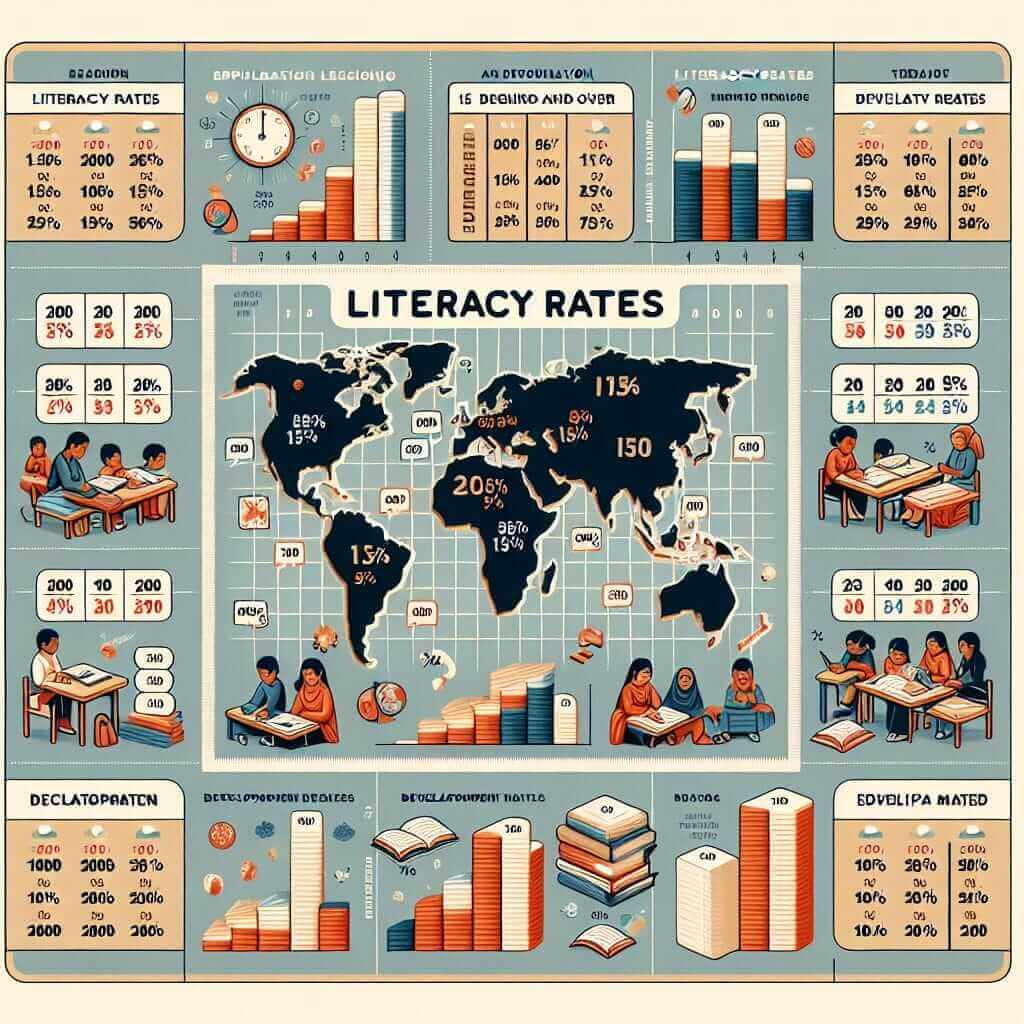The ability to read and write, or literacy, is a fundamental human right and a crucial factor in socio-economic development. The topic of “Literacy Rates in Developing Countries” frequently appears in IELTS Writing Task 1, requiring you to analyze and report on data presented in charts, graphs, or tables. This article will guide you through understanding, analyzing, and writing about this important topic to help you achieve a Band 7+ score.
Potential IELTS Writing Task 1 Questions:
Here are some potential questions you might encounter related to literacy rates in developing countries:
- The line graph shows the literacy rates of males and females in four different developing countries from 2000 to 2020. Summarize the information by selecting and reporting the main features and making comparisons where relevant.
- The table illustrates the percentage of the population aged 15 and above who are literate in various developing regions from 2000 to 2020. Write a report for a university lecturer describing the information shown.
- The bar chart compares the literacy rates of different regions in a developing country in 2000 and 2020. Summarize the information by selecting and reporting the main features and make comparisons where relevant.
Sample IELTS Writing Task 1 Question & Analysis
Let’s choose one of these potential questions and develop a sample answer.
Question:
The table below shows the percentage of the population aged 15 and above who are literate in various developing regions from 2000 to 2020. Write a report for a university lecturer describing the information shown.
Table:
| Region | 2000 | 2010 | 2020 |
|---|---|---|---|
| Sub-Saharan Africa | 52% | 60% | 68% |
| South Asia | 58% | 65% | 72% |
| Latin America & Caribbean | 88% | 92% | 94% |
| East Asia & Pacific | 90% | 94% | 96% |

Analysis:
- Type of data: The table presents data in percentages.
- Time period: The data covers a 20-year period, with specific data points for 2000, 2010, and 2020.
- Key information: The table highlights the literacy rates in different developing regions over two decades.
Model Answer:
The table provides a comparative overview of literacy rates among adults aged 15 and over in several developing regions from 2000 to 2020. Overall, there has been a positive trend of increasing literacy rates across all regions, albeit at varying paces.
In 2000, Latin America & the Caribbean boasted the highest literacy rate at 88%, followed closely by East Asia & the Pacific at 90%. In contrast, Sub-Saharan Africa had the lowest rate at 52%, with South Asia slightly ahead at 58%.
Over the following decade, all regions experienced improvements in literacy. Notably, Sub-Saharan Africa and South Asia showed the most significant gains, with increases of 8% and 7% respectively. By 2010, the literacy rate in Latin America & the Caribbean had risen to 92%, while East Asia & the Pacific reached 94%.
By 2020, literacy rates continued their upward trajectory. Sub-Saharan Africa reached 68%, while South Asia reached 72%. Both Latin America & the Caribbean and East Asia & the Pacific demonstrated further progress, reaching 94% and 96% respectively.
In conclusion, while disparities in literacy rates persist across developing regions, the data reflects a positive global trend of improvement over the two decades. (Word count: 175)
Notes on Language and Structure:
- Paraphrasing: Avoid simply copying the language from the question. Use synonyms and rephrased sentences to demonstrate your vocabulary range. For example, instead of “shows,” use “provides,” or “illustrates.”
- Comparing and Contrasting: Use comparative language such as “higher than,” “lower than,” “while,” “in contrast,” “on the other hand,” etc.
- Trend Language: Use verbs and adverbs to describe trends like “increase,” “decrease,” “rise,” “fall,” “steadily,” “significantly,” etc.
- Data Specificity: Be precise when referring to data points. Don’t just say “increased” – specify the amount of increase.
- Organization: Structure your answer with a clear introduction, body paragraphs focusing on key trends, and a concise conclusion.
Vocabulary:
- Literacy Rate (n.) /ˈlɪtərəsi reɪt/: The percentage of the population in a given area that can read and write.
- Trend (n.) /trend/: A general direction of change over time.
- Disparity (n.) /dɪˈspærəti/: A noticeable and often unfair difference between two or more things.
- Trajectory (n.) /trəˈdʒɛktəri/: The path followed by something (like a trend) over time.
- Albeit (conj.) /ɔːlˈbiːɪt/: Although; even though.
Tips for Achieving a Band 7+
- Understand the Rubric: Familiarize yourself with the IELTS Writing Task 1 band descriptors. Pay attention to the criteria for Task Achievement, Coherence and Cohesion, Lexical Resource, and Grammatical Range and Accuracy.
- Practice Regularly: Consistent practice is key. Work through numerous IELTS Writing Task 1 questions, focusing on different data presentation formats.
- Get Feedback: Seek feedback from experienced IELTS instructors or language partners to identify areas for improvement in your writing.
- Proofread Carefully: Always proofread your work for any grammatical or spelling errors.
By following these strategies and honing your analytical and writing skills, you’ll be well-equipped to achieve a Band 7+ in the IELTS Writing Task 1 section.